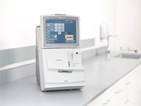Pleural Fluid pH Testing Now Available On Siemens RAPIDPoint 500 Blood Gas Analyser

Laboratory quality results quickly at the point of care
Siemens Healthcare Diagnostics has received CE Mark approval to offer pleural fluid pH testing on its RAPIDPoint® 500 Blood Gas System. This provides clinicians, laboratories and coordinators with an important new diagnostic tool for use in critical care situations. Pleural fluid effusions may be a symptom of underlying illness such as heart failure, pulmonary embolism, cancer and kidney disease1.
When a patient’s pleural fluid pH is less than 7.30 (normal pleural fluid pH is estimated at 7.64), it may suggest the presence of an inflammatory or infiltrative process2. While these measurements can be taken using pH meters or indicator sticks, multiple studies have shown these methods to be less accurate than readings conducted using a blood gas analyser 3, 4,5.
The addition of pleural fluid pH testing on Siemens’ RAPIDPoint 500 system complements the analyser’s comprehensive critical care menu, which includes tests for blood gases, electrolytes, glucose and lactate and full CO-oximetry, including total neonatal bilirubin. The RAPIDPoint 500 system uses proven Siemens technology to deliver laboratory-quality results at the Point of Care in approximately 60 seconds from a single, whole blood sample. The analyser’s measurement cartridges last up to 28 days and contain a full complement of tests, reducing downtime and increasing efficiency.
For more information about pleural fluid testing on the RAPIDPoint 500 system, please visit www.siemens.com/rp500pf
1 Cleveland Clinic. Diseases & Conditions. Pleural Effusion - Heart & Vascular Institute Overview. Available at http://my.clevelandclinic.org/disorders/pleural_effusion/ts_overview.aspx. Accessed 3/28/12.
2 Good JT, Jr Taryle DA, Maulitz RM, et al: The diagnostic value of pleural fluid pH. Chest. 1980, 78:55-59
3 Chandler T, McCoskey E, Byrd R et al. Comparison of the use and accuracy of methods for determining pleural fluid pH. South Med J 1999; 92:214-17
4Cheng DS, Rodriquez R, Rogers J et al. Comparison of pleural fluid pH obtained using blood gas machine, pH meter, and pH indicator strip. Chest 1998; 144:1368-72
5Lesh E, Robin B. Is pH paper an acceptable, low-cost alternative to the blood gas analyzer for determining pleural fluid pH? Chest 1997; 112:1291-92
6Colic Gl, Curtis A. Deslauriers J, et al: Medical and surgical treatment of parapneuomonic effusions: An evidence-based guideline (AACP consensus statement) Chest 2000, 188:1158-1171
Source: Siemens Healthcare
